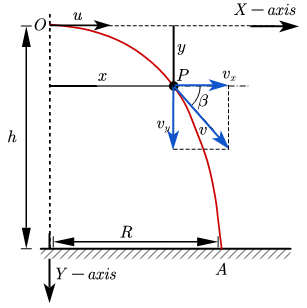
Note that the only common variable between the motions is time, t. Solve for the unknowns in the two separate motions-one horizontal and one vertical. Vertical Motion – Acceleration is due to gravity and therefore constant (a y = 9.8m/s 2 ↓) Horizontal Motion – The x-component of velocity is constant (V x = V 0x = constant) The kinematic equations for horizontal and vertical motion take the following forms: Treat the motion as two independent one-dimensional motions, one horizontal with constant velocity and the other vertical with constant acceleration. Resolve or break the motion into horizontal and vertical components along the x- and y-axes.

The following steps are then used to analyze projectile motion: As is customary, we call the horizontal axis the x-axis and the vertical axis the y-axis. This choice of axes is the most sensible because the acceleration due to gravity is vertical-thus, there will be no acceleration along the horizontal axis when air resistance is negligible. The key to analyzing two-dimensional projectile motion is to break it into two motions, one along the horizontal axis and the other along the vertical. The most important fact to remember here is that motions along perpendicular axes are independent and thus can be analyzed separately. The following simulation shows a ball being projected below horizontal, horizontally, and at angles above the horizontal. In this section, we consider two-dimensional projectile motion, such as that of a football or other object for which air resistance is negligible. The motion of falling objects is a simple one-dimensional type of projectile motion in which there is no horizontal movement. The object is called a projectile, and its path is called its trajectory. Projectile motion is the motion of an object thrown or projected into the air, subject to only the acceleration of gravity.

Last Update: kinematics of projectile motion


 0 kommentar(er)
0 kommentar(er)
